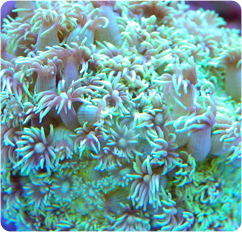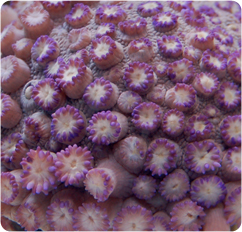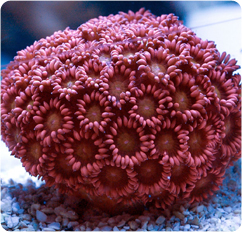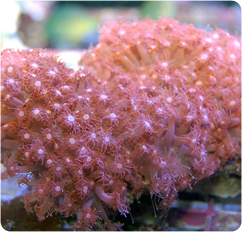|
Genus Goniopora - Flowerpot Coral
With the Proper Husbandry, this Genus' Poor Repuation May No Longer be Warrented
 |
| Metalic green Goniopora specimen with polyps partially extended. |
The coral commonly known as flowerpot coral comes from the genus Goniopora and is a strikingly beautiful stony coral with a somewhat tainted reputation in the marine aquarium industry. The genus Goniopora (pronounced goh-nee-oh-pohr-ah) is a member of the Family Poritidae, which includes other popular aquarium corals such as those from the genus Porites. Poritids are very important, as they are one of the most prolific contributors (by volume) to the world’s coral reefs. Despite the close relationship between coral specimens from the genus Porites and the genus Goniopora, these corals are actually quite different in both appearance and care.
What You Need to Know
Overall, specimens from the genus Goniopora prefer moderate light and medium to strong intermittent current. Supplemental feedings are essential in most systems, although there is still much to be learned about the dietary needs of Goniopora spp. (see below). These are very aggressive coral specimens and must be given room so that their characteristically long polyps do not come in contact with other coral specimens.
Some species of Goniopora do quite well dwelling directly on the sandbed, but many species will also do well higher on the rockwork. If placed higher on the rockwork, be sure to firmly affix this animal’s skeleton to the live rock with an aquarium safe two-part marine epoxy or other adhesive that will not harm your livestock. If your tank has clownfish that are not already hosting in an anemone or coral, think twice before adding a Goniopora specimen, as it is not uncommon to have clownfish “love this coral to death.”
 |
| Purple Goniopora specimen with polyps mostly retracted. |
A Poor Reputation
People are often drawn to Goniopora specimens because of the animal’s long, elegant polyps that are indisputably stunning and make the animal a centerpiece species in any aquarium. Traditionally, however, coral from this genus has a poor reputation in terms of survivability. In Aquarium Corals, Eric Borneman’s indispensible work on coral husbandry in the home aquarium, he writes, “Because of their poor survivability in captivity, Goniopora cannot be recommended for ongoing collection and sale.” That was 1994, and luckily today, fourteen years later, things have changed somewhat.
“We enthusiastically offer Goniopora to our customers, as most retailers do,” says Mark Martin, director of marine ornamental research at Blue Zoo Aquatics, “because we have seen dramatically increased survivability rates. In part this is due to the fact that we better understand how to collect and ship these corals, but it is also based on the fact that we know a lot more about this animal’s husbandry needs in the customer’s tank than we once did.” Martin adds that Goniopora specimens are not for everyone, nor are they for every tank set-up, but in the right environment, and with the proper husbandry, this coral can be a beautiful and long-lived addition to just about any reef.
 |
| A red Goniopora specimen living on the sand bed . |
Species Identification
There are many individual species of Goniopora, and most cannot be identified by the average hobbyist by looking at the living animal. The skeletons of these animals are often ball-like, although they can be columnar and, in rare situations, encrusting. Polyp size can extend up to a foot in some species, and each polyp has 24 tentacle tips. In terms of differentiating between species, Borneman suggests looking at the base of the skeleton. Species that are not free-living will usually have attachment scars on the base of their skeleton, whereas free-living species (like the common aquarium import, G. stokesi) will not. In the wild, these corals thrive in areas with turbid water and high sediment content, which should be a clue as to their dietary needs.
Diet – The Silver Bullet to Goniopora Captive Health?
Unlike many large polyped corals, Goniopora specimens seem to prefer small food items (e.g. phytoplankton), and it follows that a tank that is “too clean” may not provide for the dietary needs of these animals. Perhaps this is why many beginning aquarists report success with Goniopora spp. over their first six to eight months of reefkeeping and then a gradual decline and death of the animal “for no apparent reason.” In short, the better the novice aquarist becomes at reducing organics from the water column, the worse the Goniopora does. Borneman points out that “[t]anks using algal turf scrubbers seem to have some success with Goniopora, and there is some speculation that this is due to the increased microfauna associated with those systems.” In other words, perhaps Goniopora is not well-suited for the modern American reef aquarium, which tends to be overskimmed and ultra clean.
Luckily, there is some good anecdotal evidence that Goniopora species can in fact do well in a modern reef tank, even with reasonable protein skimming. The reason for this is the profusion of coral foods that have hit the market, not to mention the widespread availability of cultured phytoplankton. Better understanding how to feed Goniopora specimens may be the single most important aspect of insuring longevity in the captive environment.
 |
| While less common, Goniopora does come in encrusting and other growth forms. . |
Conclusion
In the final equation, this genus’ poor reputation may be based more on history than contemporary husbandry. With a little bit of understanding about this animal’s biology and natural environment, hobbyists, even beginning ones, are having more and more success with Goniopora species in the home aquarium.
Published 4 August 2008. © Blue Zoo Aquatics
|